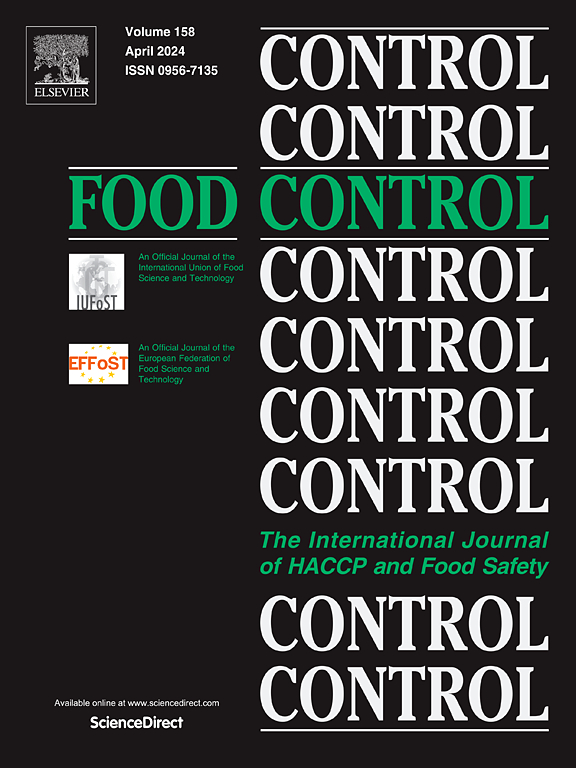早餐麦片生产过程中呋喃、烷基呋喃和丙烯酰胺的形成:模型实验与工业过程的比较
IF 6.3
1区 农林科学
Q1 FOOD SCIENCE & TECHNOLOGY
引用次数: 0
摘要
呋喃和烷基呋喃以及丙烯酰胺是在食品热处理过程中形成的过程污染物。早餐谷物的生产包括不同的加工步骤,如挤压烹饪、膨化或烘烤。本研究对模型实验和工业生产过程中呋喃和丙烯酰胺的形成进行了研究和比较。呋喃和丙烯酰胺在枪膨化谷物中的含量最高,呋喃为140 μg/kg, 2-甲基呋喃为82 μg/kg, 2-戊基呋喃为62 μg/kg,丙烯酰胺为302 μg/kg。在这个过程中,随着产品体积重量的减少,过程污染物的形成明显增加。后者通过在生产过程中提高膨化温度和压力来实现。在烘烤过程中,呋喃和丙烯酰胺的生成也很高,烘烤后的平均值为52 μg/kg呋喃、24 μg/kg 2-MF、27 μg/kg 2-PF和89 μg/kg丙烯酰胺。在此步骤中,达到最高温度输入,产品干燥,将平均水分从28%降至3.4%。在挤压产品制造过程中,呋喃和丙烯酰胺的形成明显不同,其中大多数呋喃的形成发生在挤压蒸煮过程中,而丙烯酰胺的水平主要在随后的烘烤和干燥过程中增加。挤压蒸煮后平均含量为47 μg/kg呋喃、17 μg/kg 2-MF、36 μg/kg 2-PF和96 μg/kg丙烯酰胺,烘烤干燥后平均含量为52 μg/kg呋喃、21 μg/kg 2-MF、48 μg/kg 2-PF和187 μg/kg丙烯酰胺。用于早餐谷物的涂层材料不是呋喃的主要来源。相反,由于额外的产品重量,糖涂层可能会降低最终产品中的呋喃和丙烯酰胺含量。本文章由计算机程序翻译,如有差异,请以英文原文为准。
Formation of furan, alkylfurans and acrylamide during breakfast cereal manufacturing: Comparison of model experiments with industrial processes
Furan and alkylfurans as well as acrylamide are process contaminants formed during thermal treatment of food. Breakfast cereal production includes different processing steps like extrusion cooking, puffing or toasting. In this study the furan and acrylamide formation in model experiments as well as during industrial processes were investigated and compared. Highest levels of furans and acrylamide were observed in gun-puffed grain with up to 140 μg/kg furan, 82 μg/kg 2-methylfuran, 62 μg/kg 2-pentylfuran and 302 μg/kg acrylamide. For this process, a strong increase of process contaminant formation with decreasing product bulk weight was observed. The latter is achieved by raising puffing temperature and pressure during production. High formation of furans and acrylamide was also observed during toasting, with 52 μg/kg furan, 24 μg/kg 2-MF, 27 μg/kg 2-PF and 89 μg/kg acrylamide concentration as mean values immediately after toasting. During this step the highest temperature input is achieved and the product dried to lower the average moisture from 28 % to 3.4 %.
Clear differences between formation of furans and acrylamide were observed during extruded product manufacturing, where most of the furan formation occurred during extrusion cooking itself while acrylamide levels mostly increased during subsequent toasting and drying. Mean levels after extrusion cooking were 47 μg/kg furan, 17 μg/kg 2-MF, 36 μg/kg 2-PF and 96 μg/kg acrylamide, while after toasting and drying 52 μg/kg furan, 21 μg/kg 2-MF, 48 μg/kg 2-PF and 187 μg/kg acrylamide were recorded. Coating materials applied to breakfast cereals are no major source of furans. Instead, sugar coatings may lower furan and acrylamide levels in the final products due to the additional product weight.
求助全文
通过发布文献求助,成功后即可免费获取论文全文。
去求助
来源期刊

Food Control
工程技术-食品科技
CiteScore
12.20
自引率
6.70%
发文量
758
审稿时长
33 days
期刊介绍:
Food Control is an international journal that provides essential information for those involved in food safety and process control.
Food Control covers the below areas that relate to food process control or to food safety of human foods:
• Microbial food safety and antimicrobial systems
• Mycotoxins
• Hazard analysis, HACCP and food safety objectives
• Risk assessment, including microbial and chemical hazards
• Quality assurance
• Good manufacturing practices
• Food process systems design and control
• Food Packaging technology and materials in contact with foods
• Rapid methods of analysis and detection, including sensor technology
• Codes of practice, legislation and international harmonization
• Consumer issues
• Education, training and research needs.
The scope of Food Control is comprehensive and includes original research papers, authoritative reviews, short communications, comment articles that report on new developments in food control, and position papers.
 求助内容:
求助内容: 应助结果提醒方式:
应助结果提醒方式:


